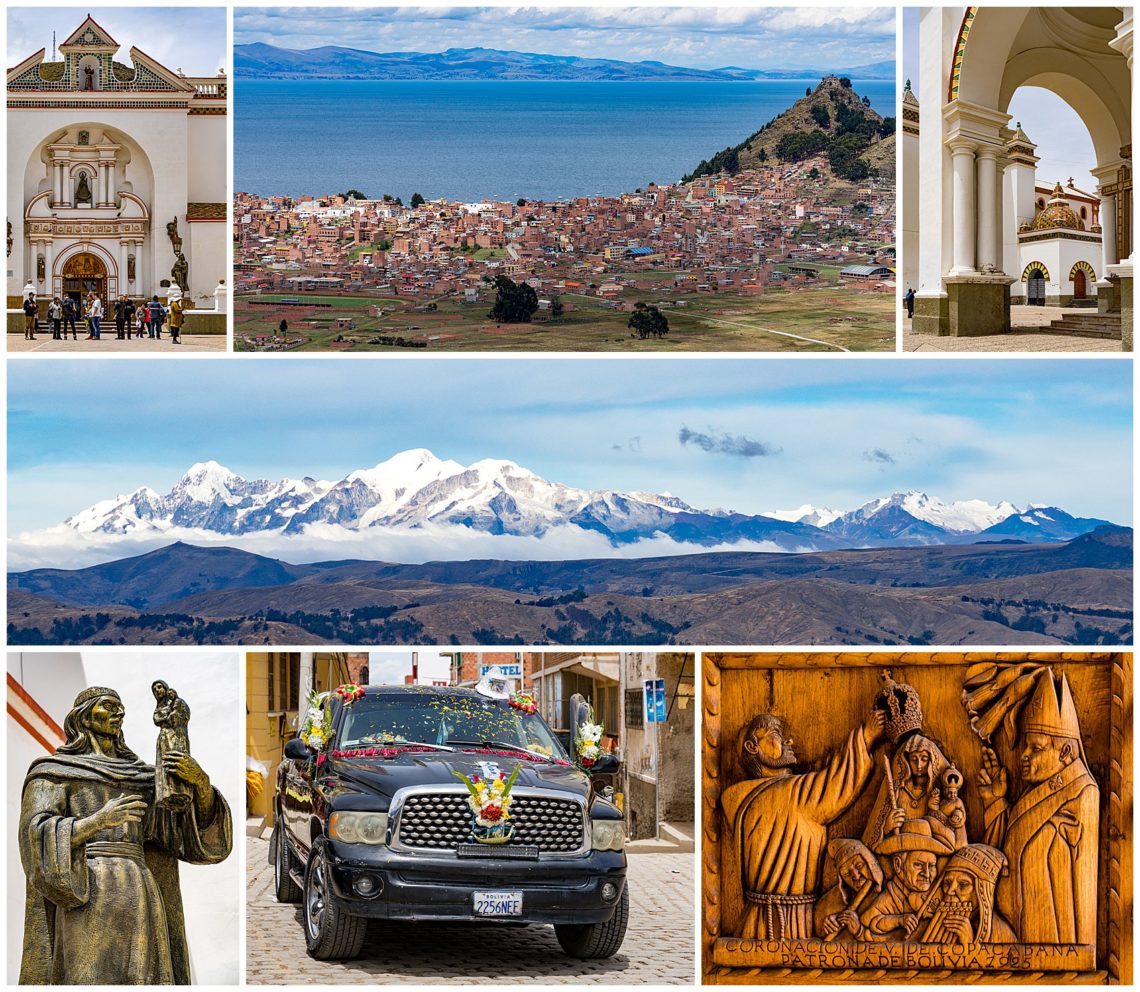
After leaving La Paz, one of our first stops was to Copacabana, on the Bolivian side of Lake Titicaca (you can see our visit to the Peruvian side last month here). To cross the lake, while staying on the Bolivian side of the border, you take tiny car ferries that only take two vehicles at a time (center and lower-center). These are basically nothing but simple flat-bottomed boats with planks to drive onto (top-center). Each ferry has two outboard motors, but only one is used at a time. The second is there as a backup, so that you are not stranded if the first motor fails

The town of Copacabana has approximately 6000 residents, and is nestled between two short mountains, near the lake’s edge (top-center). Looking across the lake gives an impressive view of the mountain range on the Peruvian side (middle). The first thing you notice upon arriving in town is the large Basilica of our Lady of Copacabana, built in the 16th century (top-left and top-right).
Bolivians have a tradition of bringing newly acquired cars to this church to be blessed, believing that doing so will prevent them from having any serious auto accidents (bottom-center). On the long drive to San Pedro, where the ferry is taken across the lake, we saw many such cars returning from the earlier ceremony of the day, fully decorated, as seen above. Many Bolivians will drive 8 or more hours to reach this blessing, and will not remove any of the decorations until they arrive back home.

Around the church are numerous vendors, primarily selling items to decorate cars for these blessings (top row and lower-right). Because we arrived after the morning’s celebration, many of the people were resting and talking among themselves in small groups (center). Of interest is that Bolivian women do not like to get their photos taken. Our guide suggested that many Bolivian women do not feel attractive enough for a photo. We marveled at how attractive the traditional clothing is in Bolivia, with the different style hats designating which regions the various indigenous groups originate, similar to the culture of the indigenous in Ecuador.

The Copacobana beach is a playground for kids of all ages. There are dozens of water toys to ride around the area, such as the adults on the dragon (center), waiting to be towed by a motorboat that will turn into a bucking monster trying to throw the riders off its back once it gets up to speed. We were curious to see one mother shove off a swan (lower-left) occupied only by two young children, maybe 3 and 5 at most. Though the mother kept an eye on the boat from the shore, she was clearly letting the children learn how to control the boat of their own, while not being constantly supervised.

Copacabana is the launch point to reach the Isla del Sol, a sacred Inca religious site. When we arrived, we found the locals heavily involved in renovation of the building, which had been damaged recently. We were told that everyone here was a volunteer, and they put in time each month as part of their civic duty to their town, in this case trying to improve the shrine to attract more tourists.
All the work was done manually, with nothing more advanced than a pick or shovel in sight. The women would line up at the bottom (top-left), and then carry heavy rocks from the pier up to the shrine (top-right), resting briefly between trips before bringing more rocks (middle row). The men did the digging, and the constructing of the wall (bottom row). The overall image center-right, shows most of the town’s crew working when we were there. We found it curious that the women were doing the heavy lifting of the stones from the boat and climbing the hill, whereas the men were on top either supervising or reconstructing the wall.
